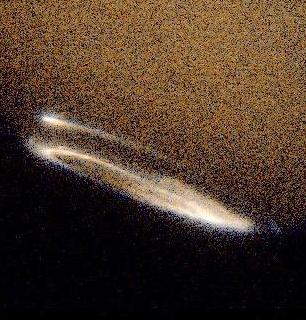Astronomy Picture of the Day
Discover the cosmos! Each day a different image or photograph of our fascinating universe is featured, along with a brief explanation written by a professional astronomer.
January 23, 1998

|

|
Discover the cosmos! Each day a different image or photograph of our fascinating universe is featured, along with a brief explanation written by a professional astronomer.
January 23, 1998

|

|
Explanation: These two recently released Hubble Space Telescope close-ups show the Northern and Southern lights ... on Jupiter. Like aurora on Earth, these Jovian aurora are caused by charged particles funneled into the atmosphere above the planet's North (right) and South poles by magnetic fields. But Jupiter's magnetic field is extremely large and ionized material expelled from the volcanic moon Io is trapped in it creating light shows 1,000 times more intense than Earth's auroral storms. Charged particles released by Io are also funneled along magnetic flux tubes which form a direct "bridge" to the Jovian atmosphere. The result is auroral hot spots - magnetic footprints 600 or more miles across which race over Jupiter's cloud tops. A hot spot is visible in both images as a comet-like feature just outside the polar auroral rings. In these false color ultraviolet images, Jupiter's limb (edge) appears dull brown while the auroral displays are shades of white and blue.
這兩張最近發布的哈伯太空望遠鏡特寫影像,呈現了木星的北極光和南極光。 類似地球上的極光,這些木星極光是因磁場把帶電粒子引導到這顆行星的北極(右)和南極,並衝撞其上空的大氣所觸發的。 但木星的磁場極端強大,來自火山活動頻乃的木衛一所噴發的電離物質被侷束在其中,形成明亮壯觀、比地球極光風暴要強烈1000倍的木星極光。 木衛一釋出的帶電粒子也沿著磁通管泛流,形成直接連接到木星的“橋樑”。 其直接結果為極光上、寬度超過960公里的熱點,而這個磁足印更飛快的掃掠過木星的雲頂。 另一個具有彗星外觀的熱點位在極光環的外頭。 在這兩張假色紫外光影像裡,木星的臨邊的色澤為暗棕,而極光則以白及藍色系來呈現。
Authors & editors:
Robert Nemiroff
(MTU) &
Jerry
Bonnell (USRA)
NASA Technical Rep.:
Jay Norris.
Specific rights apply.
A service of:
LHEA
at
NASA/
GSFC
&:
Michigan Tech. U.